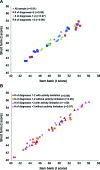Neuro-QOL: brief measures of health-related quality of life for clinical research in neurology
- PMID: 22573626
- PMCID: PMC3369516
- DOI: 10.1212/WNL.0b013e318258f744
Neuro-QOL: brief measures of health-related quality of life for clinical research in neurology
Abstract
Objective: To address the need for brief, reliable, valid, and standardized quality of life (QOL) assessment applicable across neurologic conditions.
Methods: Drawing from larger calibrated item banks, we developed short measures (8-9 items each) of 13 different QOL domains across physical, mental, and social health and evaluated their validity and reliability. Three samples were utilized during short form development: general population (Internet-based, n = 2,113); clinical panel (Internet-based, n = 553); and clinical outpatient (clinic-based, n = 581). All short forms are expressed as T scores with a mean of 50 and SD of 10.
Results: Internal consistency (Cronbach α) of the 13 short forms ranged from 0.85 to 0.97. Correlations between short form and full-length item bank scores ranged from 0.88 to 0.99 (0.82-0.96 after removing common items from banks). Online respondents were asked whether they had any of 19 different chronic health conditions, and whether or not those reported conditions interfered with ability to function normally. All short forms, across physical, mental, and social health, were able to separate people who reported no health condition from those who reported 1-2 or 3 or more. In addition, scores on all 13 domains were worse for people who acknowledged being limited by the health conditions they reported, compared to those who reported conditions but were not limited by them.
Conclusion: These 13 brief measures of self-reported QOL are reliable and show preliminary evidence of concurrent validity inasmuch as they differentiate people based upon number of reported health conditions and whether those reported conditions impede normal function.
Figures
Comment in
-
Patient-reported outcomes: progress toward speaking the patient's language.Neurology. 2012 Jun 5;78(23):1813-4. doi: 10.1212/WNL.0b013e318258f878. Epub 2012 May 9. Neurology. 2012. PMID: 22573624 No abstract available.
References
-
- Wiklund I. Assessment of patient-reported outcomes in clinical trials: the example of health-related quality of life. Fundam Clin Pharmacol 2004; 18: 351– 363 - PubMed
-
- Heffernan C, Jenkinson C. Measuring outcomes for neurological disorders: a review of disease-specific health status instruments for three degenerative neurological conditions. Chronic Illn 2005; 1: 131– 142 - PubMed
-
- Epton J, Harris R, Jenkinson C. Quality of life in amyotrophic lateral sclerosis/motor neuron disease: a structured review. Amyotroph Lateral Scler 2009; 10: 15– 26 - PubMed
-
- Leone MA, Beghi E, Righini C, Apolone G, Mosconi P. Epilepsy and quality of life in adults: a review of instruments. Epilepsy Res 2005; 66: 1– 3 - PubMed
-
- Riazi A. Patient-reported outcome measures in multiple sclerosis. Int MS J 2006; 13: 92– 99 - PubMed
Publication types
MeSH terms
Grants and funding
LinkOut - more resources
Full Text Sources
Other Literature Sources
Medical

